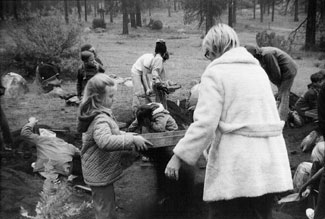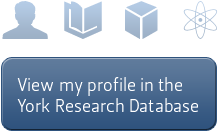Holly Wright
Visit Holly Wright's profile on the York Research Database to:
- See a full list of publications
- Browse activities and projects
- Explore connections, collaborators, related work and more
Profile
Biography
https://orcid.org/0000-0002-3403-4159
Originally from California, Holly had her first brush with archaeology as a kid at the USC Idyllwild Arts summer programme in the San Bernardino mountains.

Digging with her mother (and looking very serious).
This experience lay dormant for quite some time, and she went on to attend the University of California at Santa Cruz (go Slugs!), obtaining a BFA in Art (drawing and painting) and a BA in Art History (architectural history). After moving to Minnesota, she worked in the non-profit arts sector in a variety of creative and administrative roles for 12 years, including eight years at the innovative community arts centre Intermedia Arts; eventually drawing on her undergrad education in visual art, alongside a growing interest in computing, as the graphic design and IT manager.
While at Intermedia, she attended a conference about the art, architecture and archaeology of Albania, was exposed to archaeology once again, and caught the 'bug'. Having no formal training in archaeology, she did the equivalent of an undergrad degree in anthropology at the University of Minnesota, and gained as much fieldwork experience as possible, while continuing to work.
She went on to be operations manager at the Minnesota Alliance for Arts in Education for a further four years, and was then ready to combine her interests in the arts, archaeology and computing, coming to the University of York to pursue an MSc in Archaeological Information Systems in 2002. Graduating with distinction in 2003, her dissertation, titled Scalable Vector Graphics: An Exploration of Potential Archaeological Applications, was centred on archaeology and the use of SVG, which is the W3C recommendation for vector graphics. A distillation of this research can be found in Archaeological Vector Graphics and SVG: A case study from Cricklade in Internet Archaeology.
Returning to Minnesota, she worked for the Cultural Resource Management firm The 106 Group, as an archaeologist and graphics specialist. In 2005 she was awarded a EU Marie Curie CHIRON fellowship and returned to York to pursue a PhD, centred on archaeology and the Semantic Web, supervised by Professor Julian Richards. Upon completion of her Marie Curie fellowship, she was hired as Research Manager for the Department of Archaeology, where she used her non-profit administration experience to support external research funding efforts, in particular the European funding portfolio.
She completed her PhD in 2011, titled Seeing Triple: Archaeology, Field Drawing and the Semantic Web, and is delighted to be working as International Projects Manager for the Archaeology Data Service, allowing her to combine all her research and administrative interests and skills, and continue living and working in the beautiful and historic City of York.
Research
Overview
My PhD research centred on how archaeological field data, and in particular the spatial information held in field drawings can be made part of the Semantic Web. This thesis is available via White Rose eTheses: http://etheses.whiterose.ac.uk/2194/
Scalable Vector Graphics: An Exploration of Potential Archaeological Applications
My MSc dissertation, Scalable Vector Graphics: An Exploration of Potential Archaeological Applications, was an analyses of SVG and its potential as a tool for bringing vector based archaeological information to the Web. A distillation of this research was published in 2006 as Archaeological Vector Graphics and SVG: A case study from Cricklade inInternet Archaeology (Issue 20).
Projects
Saving European Archaeology from the Digital Dark Age (SEADDA)
COST Action SEADDA (CA18128) is funded by the Horizon 2020 Framework Programme of the European Union, and is an international community of archaeologists and digital specialists working together to secure the future of archaeological data across Europe and beyond. It is comprised of four working groups focussed on understanding the current state-of-the-art regarding the preservation, dissemination and re-use of archaeological data and developing common understandings around international best practice for the preservation, dissemination and re-use of archaeological data, and establish the field as a priority area for research. SEADDA has over 100 members representing 32 COST countries and four International Partner Countries.
Advanced Research Infrastructure for Archaeological Dataset Networking Plus (ARIADNEplus)
The ARIADNEplus project is the extension of the previous ARIADNE Integrating Activity, which successfully integrated archaeological data infrastructures in Europe, indexing in its registry about 2.000.000 datasets. ARIADNEplus will build on the ARIADNE results, extending and supporting the research community that the previous project created and further developing the relationships with key stakeholders such as the most important European archaeological associations, researchers, heritage professionals, national heritage agencies.
https://ariadne-infrastructure.eu/

Social Sciences and Humanities Open Cloud (SSHOC)
SSHOC is a project funded by the European Union as part of the Horizon 2020 program for research and innovation. While different European research endeavours and infrastructures exist, the purpose of the SSHOC project is to make them converge towards a coherent set of services provided by the European Open Science Cloud (EOSC). The EOSC portal aims to gather data, tools and training resources made accessible through a simplified methodology for the benefit of the wider community.
![]()
European Research Infrastructure for Heritage Science (E-RIHS)
E-RHIS will support research on heritage interpretation, preservation, documentation and management. It will comprise E-RIHS Headquarters and National Hubs, fixed and mobile national infrastructures of recognized excellence, physically accessible collections/archives and virtually accessible heritage data. Both cultural and natural heritage are addressed: collections, buildings, archaeological sites, digital and intangible heritage. E-RIHS will provide state-of-the-art tools and services to crossdisciplinary research communities advancing understanding and preservation of global heritage. It will provide access to a wide range of cutting-edge scientific infrastructure, methodologies, data and tools, training in the use of these tools, public engagement, access to repositories for standardized data storage, analysis and interpretation. E-RIHS will enable the community to advance heritage science and global access to the distributed infrastructures in a coordinated and streamlined way.

ARCHaelogical Automatic Interpretation and Documentation of cEramics (ArchAIDE)
ArchAIDE is funded by the EU Horizon 2020 research and innovation programme and aims to create a new system for the automatic recognition of archaeological pottery from excavations around the world. ArchAIDE will develop a new app meant to serve the global practice of archaeology, using the latest automatic image recognition technology to aid in the identification of ceramics. Currently, the characterisation and classification of ceramics is carried out manually, through the expertise of specialists and the use of analogue catalogues held in archives and libraries. The goal of ArchAIDE is to optimise and economise this process, making knowledge accessible wherever archaeologists are working.
Research group(s)
- University of York Digital Archaeology research group
Grants
- EU Marie-Curie CHIRON Research Fellow
Publications
Selected publications
2020
Anichini, F, Banterle, F, Buxeda i Garrigós, J, Callieri, M, Dershowitz, N, Dubbini, N, Lucendo Diaz, D, Evans, T, Gattiglia, G, Green, K, Gualandi, M L, Hervas, M A, Itkin, B, Madrid i Fernandez, M, Miguel Gascón, E, Remmy, M, Richards, J, Scopigno, R, Vila, L, Wolf, L, Wright, H, Zallocco, M (2020) Developing the ArchAIDE Application: A digital workflow for identifying, organising and sharing archaeological pottery using automated image recognition, Internet Archaeology 52. https://doi.org/10.11141/ia.52.7
2018
Wright, H and Richards, J D (2018) Reflections on Collaborative Archaeology and Large-Scale Online Research Infrastructures. Journal of Field Archaeology, 43:sup1, S60-S67, https://doi.org/10.1080/00934690.2018.1511960
Morgan, C and Wright, H (2018) Pencils and Pixels: Drawing and Digital Media in Archaeological Field Recording. Journal of Field Archaeology, 1-16. https://doi.org/10.1080/00934690.2018.1428488
Wright, H (2108) Semantic Web and Ontologies, In The Encyclopedia or Archaeological Sciences, S. L. López Varela (Ed.). https://doi.org/10.1002/9781119188230.saseas0527
2017
, K, , A, , H, Archaeology, Heritage, and Social Value: Public Perspectives on European Archaeology. European Journal of Archaeology, 1-22. http://dx.doi.org/10.1017/eaa.2017.19
Aloia, N, Binding, C, Cuy, S, Doerr, M, Fanini, B, Felicetti, A, Fihn, J, Gavrilis, D, Geser, G, Hollander, H, Meghini, C, Niccolucci, F, Nurra, F, Papatheodorou, C, Richards, J, Ronzino, P, Scopigno, R, Theodoridou, M, Tudhope, D, Vlachidis, A, Wright, H (2017) Enabling European Archaeological Research: The ARIADNE E-Infrastructure, Internet Archaeology 43. https://doi.org/10.11141/ia.43.11
Meghini, C, Scopigno, R, Richards, J D, Wright, H, Geser, G, Cuy, S, Fihn, J, Fanini, B, Hollander, H, Niccolucci, F, Felicetti, A, Ronzino, P, Nurra, F, Papatheodorou, C, Gavrilis, D, Theodoridou, M, Doerr, M, Tudhope, D, Binding, C, Vlachidis, A, (2017) ARIADNE: A Research Infrastructure for Archaeology, Journal on Computing and Cultural Heritage (JOCCH) - Special Issue on Digital Infrastructure for Cultural Heritage, Part 2, Volume 10 Issue 3. https://doi.org/10.1145/3064527
2011
Wright, H (2011) Seeing Triple: Archaeology, Field Drawing and the Semantic Web. PhD Thesis: University of York. http://etheses.whiterose.ac.uk/id/eprint/2194
2007
Wright, H (2007) Explorations in Archaeological Visualisation: Using XML technologies for Visualising Anglo-Saxon settlement in the Northern England. IN P. in S. Hermon and F. Niccolucci (eds) Communicating Cultural Heritage in the 21st Century, EPOCH, 41-51
Wright, H (2007) XML Based Visualisation in Archaeology. IN J. T. Clark and E. M. Hagemeister (eds) Digital Discovery: Exploring New Frontiers in Human Heritage. Budapest: ARCHAEOLINGUA.
2006
Wright, H (2006) Archaeological Vector Graphics and SVG: A case study from Cricklade, Internet Archaeology, 20. https://doi.org/10.11141/ia.20.1
Teaching

Contact details
http://archaeologydataservice.ac.uk/

